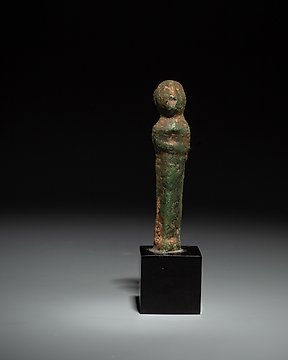
iberyjski Brązowy Exvoto. IV - III wiek p.n.e. Wysokość 6 cm.
Nr 83804557

Nr 83804557

Female figure of Goddess Artemis with a deer
Greek, Tanagra, 3rd - 4th century BC
Terracotta
Height 15,5 cm
PROVENANCE: Private collection Mr. Schoulmers, Belgium. Acquired in Sotheby's, New York, 29 April 1999, lot 665.
CONDITION: Good condition.
DESCRIPTION:
Artemis, in Greek religion, the goddess of wild animals, the hunt, and vegetation and of chastity and childbirth; she was identified by the Romans with Diana. Artemis was the daughter of Zeus and Leto and the twin sister of Apollo. Among the rural populace, Artemis was the favourite goddess. Her character and function varied greatly from place to place, but, apparently, behind all forms lay the goddess of wild nature, who danced, usually accompanied by nymphs, in mountains, forests, and marshes. Artemis embodied the sportsman’s ideal, so besides killing game she also protected it, especially the young; this was the Homeric significance of the title Mistress of Animals.
The worship of Artemis probably flourished in Crete or on the Greek mainland in pre-Hellenic times. Many of Artemis’s local cults, however, preserved traces of other deities, often with Greek names, suggesting that, upon adopting her, the Greeks identified Artemis with nature divinities of their own. The virginal sister of Apollo is very different from the many-breasted Artemis of Ephesus, for example.
Dances of maidens representing tree nymphs (dryads) were especially common in Artemis’s worship as goddess of the tree cult, a role especially popular in the Peloponnese. Throughout the Peloponnese, bearing such epithets as Limnaea and Limnatis (Lady of the Lake), Artemis supervised waters and lush wild growth, attended by nymphs of wells and springs (naiads). In parts of the peninsula her dances were wild and lascivious.
Outside the Peloponnese, Artemis’s most familiar form was as Mistress of Animals. Poets and artists usually pictured her with the stag or hunting dog, but the cults showed considerable variety. For instance, the Tauropolia festival at Halae Araphenides in Attica honoured Artemis Tauropolos (Bull Goddess), who received a few drops of blood drawn by sword from a man’s neck.
The frequent stories of the love affairs of Artemis’s nymphs are supposed by some to have originally been told of the goddess herself. The poets after Homer, however, stressed Artemis’s chastity and her delight in the hunt, dancing and music, shadowy groves, and the cities of just men. The wrath of Artemis was proverbial, for to it myth attributed wild nature’s hostility to humans. Yet Greek sculpture avoided Artemis’s unpitying anger as a motif. In fact, the goddess herself did not become popular as a subject in the great sculptural schools until the relatively gentle 4th-century-BCE spirit prevailed.
At the end of the 4th Century BC a style of modeling clay called “Tanagra style” was developed. The name comes from the city of the same name, a center of production of terracotta figurines. The term alludes to a female figure, generally one standing, wearing a long draped chiton, over which was thrown a fine wide cloak. These women also often wore shoes, wide pointed hats and carried fans. They rarely carried other objects and in place of these, the arms and hands were wrapped in the cloak which could also be used to cover the head, and sometimes to almost completely cover the face.
NOTES:
This lot is Guaranteed to be Authentic and Genuine and will include a Certificate of Authenticity.
The seller can prove that the lot was obtained legally, provenance statement seen by Catawiki.
Important information. The seller guarantees that he is entitled to sell/export this lot.
The seller will take care that any necessary permits, like an export license will be arranged.
The seller will inform the buyer about the status of it if this takes more than a few days.
THE MINISTRY OF CULTURE FROM SPAIN ASKS ALL SELLERS FOR INVOICES OR OTHER DOCUMENTATION ABLE TO PROVE THE LEGALITY OF EACH ITEM BEFORE PROVIDING AN IMPORT OR EXPORT LICENSE.
#MorganNiquetCollection
Jak kupować w serwisie Catawiki
1. Odkryj coś wyjątkowego
2. Złóż najwyższą ofertę
3. Dokonaj bezpiecznej płatności